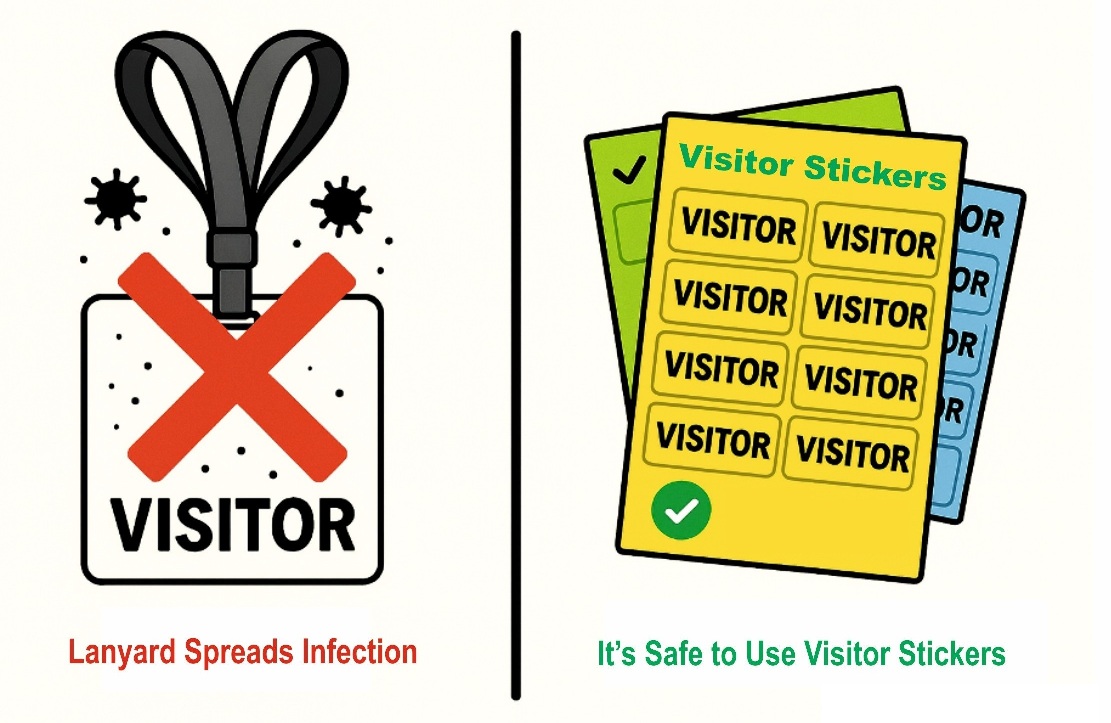Visitor Lanyards vs. Visitor Stickers: Why It’s Time to Make the Switch
Published on 8/27/2025 • Updated on 8/27/2025

When it comes to visitor management, most companies (nearly 95%) still rely on visitor lanyards. They’ve been the default method for years simple, reusable, and easy to spot. But beneath this convenience lies a major problem: lanyards are rarely cleaned and often used for years without replacement. This creates a hidden but serious infection risk, as germs can spread from one visitor to another, and even to your employees, through handshakes, shared surfaces, or contact during meetings.
It’s time to rethink this outdated practice and move toward a safer, smarter solution: Visitor Stickers.
Why Lanyards Fall Short
The original purpose of lanyards was straightforward: make visitors easy to identify while they are inside your facility. However, the very features that made them popular reusability and durability have now become their biggest drawback:
- Poor Hygiene: Reusable lanyards are handled by countless visitors over several years without being sanitized.
- Health Risk: They act as carriers for bacteria and viruses, leading to cross-infection between visitors and staff.
- Limited Identification: Most lanyards are a single color with no way to distinguish between types of visitors (factory vs. office, vendor vs. auditor, etc.).
The Smarter Alternative: Visitor Stickers
Visitor stickers are a modern, hygienic, and highly effective replacement. Instead of passing around a lanyard, each visitor gets a fresh, single-use sticker that can be easily placed on their shirt for visibility.
With stickers, your HR or admin teams can design a color-coded identification system. For example:
- Yellow Stickers → Visitors entering the factory floor
- Green Stickers → Visitors meeting staff in office areas
- Blue Stickers → Contractors or vendors
- Red Stickers → Restricted access or escorted visitors
This system makes it faster and clearer for employees and security teams to identify who’s who. It also enforces visitor compliance more effectively than a one-color lanyard ever could.
Health and Safety Benefits
Switching to stickers has direct benefits for workplace hygiene:
- Single Use = Zero Contamination: Each sticker is disposed of after the visit, eliminating infection risks.
- Protects Staff & Guests: Reduced chance of germ transfer through shared items like lanyards.
- Supports Compliance: Stickers can be designed to meet OSHA / FDA workplace safety and health policies.
Addressing the Cost Factor
Yes, stickers are slightly more expensive than re-usable lanyards. But consider the bigger picture:
- The cost of stickers is minimal compared to potential sick days, disruptions, or compliance penalties caused by infections.
- It’s a small investment in creating a safer, healthier workplace.
- Most importantly, it shows your staff and visitors that you prioritize their well-being.
How VisitorFlow Can Help
At VisitorFlow, we make this transition effortless. Our team provides ready-to-use, OSHA / FDA compliant visitor stickers, customized for your company’s needs and color-coding policy.
By adopting stickers, you can:
- Improve visitor identification and compliance
- Reduce infection risks at your workplace
- Strengthen your company’s health and safety culture
✅ It’s time to move beyond outdated lanyards.
Switch to Visitor Stickers today—because visitor management should keep people safe, not put them at risk.
- What Is Courier Management Software and Why Your Office Needs It
- Cloud-Based QR Code Visitor Management Outperforms Paper Registers and Static Desktop Software
- DPDP-Compliant Visitor Onboarding: What Security & HR Must Capture at the Gate
- Transforming Visitor Gate Passes into Legally Enforceable Visitor Experiences
- Why use Material Gate Pass Software to Manage material Movement
- Case Study Video : Incident reporting & management software
- How QR Code-Based Incident Reporting Transforms Manufacturing Operations
- Transforming Visitor Management: Ensuring Legal Compliance and IP Protection with Cloud-Based Software
- Step-by-Step Guide to Visitor Management in Manufacturing Factories
- Lanyard Infections: A Hidden Risk in Workplaces